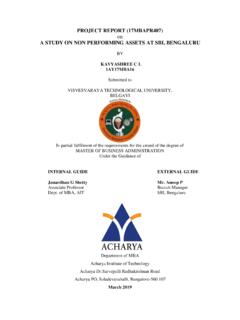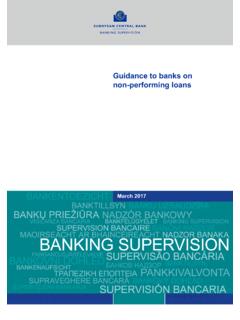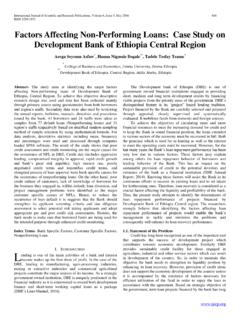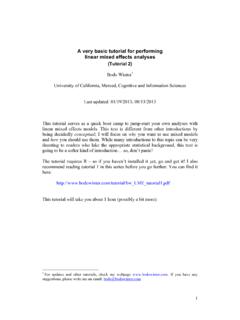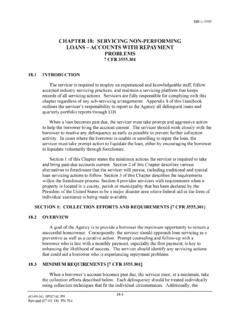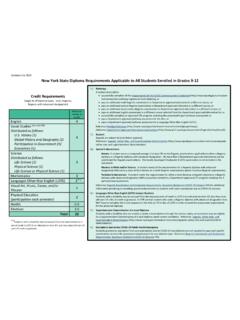Transcription of Basel Committee on Banking Supervision Guidelines
1 Basel Committee on Banking Supervision Guidelines Prudential treatment of problem assets definitions of non- performing exposures and forbearance This publication is available on the BIS website ( ). Bank for International Settlements 2016. All rights reserved. Brief excerpts may be reproduced or translated provided the source is stated. ISBN 978-92-9197-487-0 (print) ISBN 978-92-9197-488-7 (online) Guidelines for definitions of non- performing exposures and forbearance iii Contents Executive summary .. 1 1. Purpose and use of the common definitions .. 3 Mandate .. 3 Purpose and use of the common definitions .. 3 2.
2 Main harmonisation features of the definitions of non- performing exposures and forbearance . 6 Main harmonisation features of the definition of non- performing exposures .. 6 Main harmonisation features of the definition of forbearance .. 7 3. Definition of non- performing exposures .. 8 Identification of non- performing exposures .. 8 Recategorisation of non- performing exposures as performing .. 10 Additional considerations .. 11 4. Definition of forbearance .. 12 Identification of forbearance .. 12 Criteria for exit from the forborne exposures category .. 14 Interaction of forborne exposures with non- performing 14 Annex: Stocktake of key terms and practices on credit risk categorisation for loans.
3 15 Summary of main findings .. 15 Part I System issues .. 18 Part II Thematic review of key terms .. 26 Case studies .. 38 Guidelines for definitions of non- performing exposures and forbearance 1 Executive summary (i) The global financial crisis revealed difficulties for supervisors and other stakeholders in identifying and comparing banks information across jurisdictions. In particular, the Basel Committee on Banking Supervision recognised that there may be significant differences in how banks identify and report their asset quality. (ii) In response to this issue, the Basel Committee formed a dedicated task force to analyse jurisdictions and banks practices regarding asset categorisation schemes the system that requires loans to be grouped based on their credit quality and to assess the consequences of any differences in practices.
4 (iii) The Basel Committee analysed the regulatory frameworks and supervisory practices across jurisdictions through a literature review and a survey of 28 supervisors,1 as well as industry practices through a questionnaire and case studies sent to 39 banks from the 28 jurisdictions. (iv) The literature review and the outcome of the survey questionnaires confirmed that banks categorise problem loans in a variety of ways. There are no consistent international standards for categorising problem loans. (v) In addition, the analysis revealed varying practices across jurisdictions, as well as various layers of definitions within jurisdictions.
5 In particular, it noted differences in the definitions of terms used in the accounting and regulatory frameworks, such as the concept of impairment or the definition of default used for modelling purposes. The analysis also identified that more than half of the jurisdictions included in the survey had established local/national supervisory definitions for asset categorisation different from those used in the accounting framework and/or the definition of default in order to achieve consistent supervisory reporting and disclosure on asset quality driven by prudential considerations. (vi) Against this background, the Basel Committee developed Guidelines for the definitions for two important terms non- performing exposures and forbearance.
6 The definitions are built on commonalities in the existing definitions of many countries. These will help harmonise the quantitative and qualitative criteria used for credit categorisation and provide the starting point for countries with no existing definitions to develop them. (vii) The definition of non- performing exposures introduces harmonised criteria for categorising loans and debt securities that are centred on delinquency status (90 days past due) or the unlikeliness of repayment. It also clarifies the consideration of collateral in categorising assets as non- performing . The definition focuses on a debtor basis, but allows categorisation of exposures as non- performing on a transaction basis for retail exposures.
7 It also introduces clear rules regarding the upgrading of a non- performing exposure to performing and the interaction between forbearance and non- performing status. The definition of forbearance provides a harmonised view on the modification or refinancing of loans and debt securities that result from a borrower s financial difficulty. The definition allows forborne exposures to be categorised as performing or non- performing exposures. It also sets out criteria for the discontinuation of the forbearance categorisation and emphasises the need to ensure a borrower s financial soundness before the discontinuation. 1 Surveyed jurisdictions include Thailand and the 27 jurisdictions that are members of the Basel Committee .
8 2 Guidelines for definitions of non- performing exposures and forbearance (viii) These Guidelines are intended to complement the existing accounting and regulatory framework in relation to asset categorisation. They will harmonise the scope, recognition criteria, and level of application of both terms, thereby promoting a better understanding of the terms, improving identification and monitoring, and promoting consistency in the supervisory reporting and disclosures by banks. The definitions are intended to be used in the following contexts: Supervisory asset quality monitoring, including so that supervisory colleges can obtain a more consistent basis for comparison across jurisdictions; Banks internal credit categorisation systems for credit risk management purposes; Pillar 3 disclosure on asset quality;2 Dissemination of data for asset quality indicators; and A reference point for other relevant working groups of the Basel Committee .
9 (ix) In turn, this will help supervisors and banks management to identify levels of non- performing and forborne exposures in absolute and relative terms and facilitate timely action to address rising asset quality problems. 2 Specific disclosure proposals will be considered as part of the Basel Committee s ongoing review and update of the Pillar 3 requirements. Guidelines for definitions of non- performing exposures and forbearance 3 1. Purpose and use of the common definitions Mandate 1. One of the lessons learnt from the financial crisis is that supervisors and investors could not always understand and compare information about credit categorisation presented in banks financial statements.
10 Banks used different (and often undisclosed or insufficiently disclosed) methodologies and assumptions for valuations, provisioning and risk weightings, increasing opacity and reducing comparability for end users. This inconsistency increased uncertainty at the height of the crisis and frustrated supervisors and investors who tried to compare and assess banks performance and risk. 2. The Basel Committee on Banking Supervision formed a task force to analyse the range of practices with respect to the definitions of credit risk management terms, their use in credit categorisation3 schemes by banks and their supervisors, and the causes and consequences of differences.










